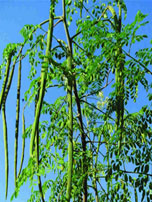SHAHEED KARTAR SINGH SARABHA AYURVEDIC MEDICAL COLLEGE & HOSPITAL
Affiliated to Guru Ravidas Ayurved University, Hoshiarpur Punjab
Affiliated to Guru Ravidas Ayurved University, Hoshiarpur Punjab

Botanical Name : Moringa pterygosperma Gaertn.
Family : Moringaceae
Introduction :
It is applied externally in krimi rogas . Leaves of Sigru are considered to be sukrala, chakusya, Vishaghna.
Scientific classification: The horseradish tree belongs to the moringa family, Moringaceae. It is classified as Moringa pterygosperma.
Names in different Indian languages :
Hindi : Sahijana
English : Drum stick plant, Horse-radish tree
Telugu : Munaga chettu
Tamil : Murungal
Malayalam : muringa
Kanada : Nuggi, Murunga
Sanskrit : Sigru, sobhanjanah
Unani : Sahajan
Synonyms :
Madhu Shigru, Sigra, Shobhaanjana, Haritashaaka. Raktaka, Murangi, Mochaka, Akshiva, Tikshnagandhaa.
Moringa oleifera Lam
Classification according to Charaka, Susrutha & Vagbhata :
Charaka
Krmighna. Svedopaga, Sirovircecanopaga, Katuka skañdha
Susrutha
Varunädi, sirovirecana
Vagbhata
Varunädi
Varieties & adulterants – (CV – controversy, AD – adulterants) :
1. Sveta Sigru & Madhu Sigru
2. Rakta Sigru or Sigruka
3. Moringa coñeanensis Nimmo
4. M. oleifera Lam
5. Sweet sigru
6. Bitter sigru
Types : Depending on the types of flowers, it is classified into two (1) white and (2) reddish white.
Morphology :
A small or medium-sized tree, growing upto 12m. Bark- corky, soft, thick, deeply fissured. Wood is soft.
Leaves: tripinnate, Rachis slender, 30.5-61.0 cm long; leaflets elliptic.
Flowers: bisexual, irregular, fragrant, white, in large panicles.
Fruits:pod, triangular ribbed, pendulous, greenish, 25-50.00 cm
Seeds : Trigonous, winged
Distribution & Habitat :
All over India.
Chemical composition :
Bark- sterols, terpenes (bayrenol)
Leaves- amino acids viz., aspartic and glutamic acid, serine.
Whole plant- moringine, moringinine, bayrenol, indole acitic acid, concanensis acid, pteregospermine, carotene etc.
Seeds: contain stable, clean, colourless oil
Root: bad smelling volatile oil
Flowers- Ouercetin, kaempferol.
Properties :
Rasa: Katu, Tikta
Guna: Laghu, Ruksa, Tiksna
Virya: usna
Vipaka: katu
Karma : Kapha-vãtahara, sukrala, Grãhi, Dipana, Hridya, chaksusya
Anti inflammatory (but irritates Kidney ) ,Cardiac and circulatory stimulant, antipyretic, anthelmintic, digestive, Anti allergic, carminative, laxative, diuretic. Cardiac tonic, antiepileptic.
Indications :
Krimi, Pimaroga, Galagama, sirahsãla, Kandü, sotha, Apaci, Vrana, Medo roga, Vidradhi, Gulma.
Rheumatic arthritis, nervous debility, asthma, enlarged liver and spleen, deep-seated inflammation
Part Used :
Panchang
Dosage :
Root bark juice 25-50 ml, seed powder 2-4 g, stem bark
Important Yogas or Formulations :
Sigru pusparasayana,sigruvadi lepa.
External uses :
A paste of bark and leaves produces burning sensation, is anti-inflammatory and acts on abscesses. It is applied topically on inflammation and abscess. Seed powder is the best shirovirechana nasya, Seed powder is administered nasally in headache and heaviness of the head produced by kapha. Seed oil is analgesic hence used in rheumatoid arthritis and painful diseases.
Internal uses :
Nervous system as it is tikshna and ushna, it is a nerve stimulant. The non crystalline part of the bark is very strong and it acts through afferent nerves on the body. Because of this, it cause hypertension, increases heart rate and contracts the blood vessels. It towers the function of muscles in respiratory as well as digestive system. Dilatation of pupil occurs similar to the action of adrenalin and ephedrine. Tender plant root is useful in epilepsy.
Digestive system : As it is pungent and tikshna, it improves appetite, is digestive,Vidahi, grahi Induces motility), analgesic, antibacterial and de-worming agent. Madhu shigru is viscous and sweet and so it is purgative. In unassimilated internal abscess. madhu shigru is used in lunch, drink and in external application also. It is useful in lose of appetite, tastelessness, pain in abdomen, ascites, gulma and worms.
Circulatory system : Due to ushna guna it acts as a stimulant to heart, creates hypertension and is anliinflamrnatonj. It is used in weakness of heart and inflammation.
Respiratory system : Kaphaghna. Useful in kaphaja kasa. Seed powder is useful for shodhana nasya.
Urinary system : As it is ushna & tikshna. it stimulates the kidneys and increases the quantity of urine. It is useful in dysuria and in increased acidity in urine. In calculi its decoction is useful. It is not used in hydronephorsis, as it irritates the kidneys and increases inflammation.
Reproductive system : It stimulates menstruation and as it is ushna and anti inflammatory, it is useful in dysmenorrhoea and obstructed menstruation.
Satmikaran : It controls medoroga and reduces effects of poison. It reduces shukra therefore one should not use it in conditions involving reduced shukra. It acts on shukra but reduces it.
Skin : Tikshna and ushna, induces sweating. Therefore its hot infusion is used in skin diseases. If there are maggots in the wound fresh bark paste is applied and bandoged on the wound. Due to its smell, all maggots come out. (Turpentine and resin ad similarly).
Temperature : Since it is a diaphoretic, its hot infusion is used in fever associated with rigors caused by obstruction of sweat. The legumes of shigru are used as diet in post . pyrexial conditions.
Eyes : The seeds are used for topical application in the eyes: It is useful in eye disorders produced by kapha.
Excess intake : As it is ushna, tikshna, it produces raktapitta and burning sensation if taken in excess dose. It is contraindicated in pitta prakriti and, raktapitta. (According to some experts, it is superior to penicillin in preventing inflammation and suppuration in traumatic ‘wounds without any side effects as in penicillin).
Important research work going on :
(1) Antimicrobial and antibacterial activity
(2) Action on Eye.
(3) Antifungal activity
(4) Antiviral activity
(5) Anti-inflammatory activity
Therapeutic Uses :
(1) Pratisyãya- Root of Sigru should be taken with ghee oil as Anupãna (G.N.)
(2) Krimi- Decoction of Sigru stem bark is given with Vidanga
& honey (V.S.).
(3) Netraroga- Eyes are cleansed with the juice Sigru leaves
(4) Dadru Kustha- Sigru root bark paste is applied locally
